Best Project Management Software for Architects in 2025: Time Tracking, Invoicing & More
There are many project management software options on the market. However, finding project management programs that can help an architectural project run smoothly can be tricky. We’ve got your back, though. Here, we’ll look at the best project management software for architects.
Architectural firms have to deal with many moving parts in their projects. Fortunately, a good project management tool can help oversee task management, time-tracking, workloads, invoicing, communications, to-do lists and more. However, not all project management software is created equally. Our experts tested dozens of products to bring you the best project management software for architects.
Key Takeaways: Architecture Project Management
- If you’re looking for one piece of project management software for task and finance management, Monograph is the software you should consider trying.
- For the complex projects that architecture firms work on, you’ll need a full suite of project management tools, like monday.com, that are usually only available in paid plans.
- Most of the architecture project management software listed here provide a free trial. Spend time with each platform to see if it can perform the jobs you need it to before signing up for a plan.
Along with project management stalwarts such as Wrike and monday.com, there are several pieces of project management software that have been designed from the ground up for architectural projects, including Monograph, which we feel is the best overall option. Below, we’ll explain why Monograph, as well as others, make our list.
For some better overall performers, check out our best project management software list, instead.
-
09/25/2023 Facts checked
Removed reference to discontinued ClickUp Business Plus plan.
-
06/07/2024
Updated the article to reflect monday.com’s latest pricing information.
What Makes the Best Project Management Software for Architects?
The best project management software for architects should create projects, communicate with teams, track time and workloads, view timelines, let you set budgets and create invoices and schedules.
To be clear, we’re not talking about architectural software that’s used to design buildings. However, we are discussing project management software for architects and what makes different project management platforms ideal for architecture and engineering firms. Here’s a look at five great project management software tools.
- Monograph — Excellent resource management features and slick interface
- monday.com — Feature-packed, easy to use and great compatibility
- Wrike — Functional project planning software that can handle any task
- TeamGantt — Perhaps the best Gantt chart tool, with powerful integrations
- ClickUp — Strong project management tool and a clean, versatile interface
If you’re looking for a single piece of software to help you manage every aspect of your project, from planning to invoicing, Monograph is the best architecture project management tool, followed by monday.com, Wrike, TeamGantt and ClickUp. They’re all powerful in their own ways. Stick with us to find out how each piece of software can help you.
The 5 Best Project Management Tools for Architects
Now that we’ve introduced you to the software we’ll be covering in this roundup, we’ll take a closer look at all the platforms to showcase their project planning features. Hopefully, by doing so, we will be able to show you why you and your firm should consider them for architectural project management.
1. Monograph
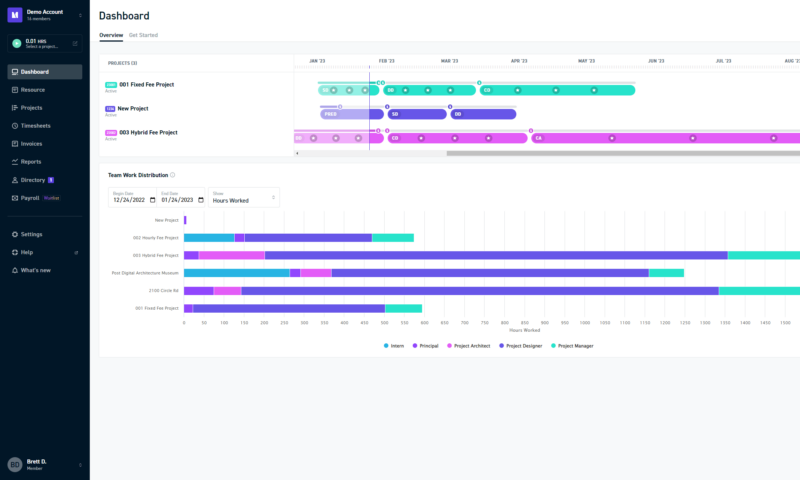
More details about Monograph:
- Pricing: $30 per user per month
- Provider website: monograph.com
Pros:
- Clean & functional interface
- Extensive financial tools
- Powerful reports
Cons:
- Steep learning curve
- Weak collaboration features
- Paid tiers are quite expensive
Monograph is a slick-looking platform that’s considered by many to be the best software solution for architectural project management, and we’d have to agree. This full-featured, all-in-one project management tool is a Gantt chart at heart, but it’s good for much more than just run-of-the-mill project planning applications.
Take a deep dive into Monograph, and you’ll see that this project management tool is a robust planner that features task and financial Gantt charts that track team members, projects, budgets and workloads. On top of this, Monograph is a financial planner that lets you track times and pay rates, make invoices and keep track of overall project spending.
Monograph can do many things, and there’s no doubt that it’s an excellent resource management tool; however, the learning curve is steep. Fortunately, nearly every feature and function of this architecture management software has a tutorial video, and a comprehensive help section will enable you to get the most out of the tool.
Money Management Features and Reports
Monograph has robust financial tools for architecture firms to utilize. The tool lets you track projects from inception to building completion and lets you track the cost of payroll and supplies. At a glance, you can see how much you’re spending, how much money is going to team members and if each portion of the project is over, under or on budget.
Managers who like to dive into numbers will also love the detailed reports Monograph generates. Everything from scheduling, tasks, spending and workloads is presented nicely in colorful, easy-to-read graphs. With these tools, architects, managers, designers, engineers and team members can start replacing messy excel spreadsheets with precise, polished reports.
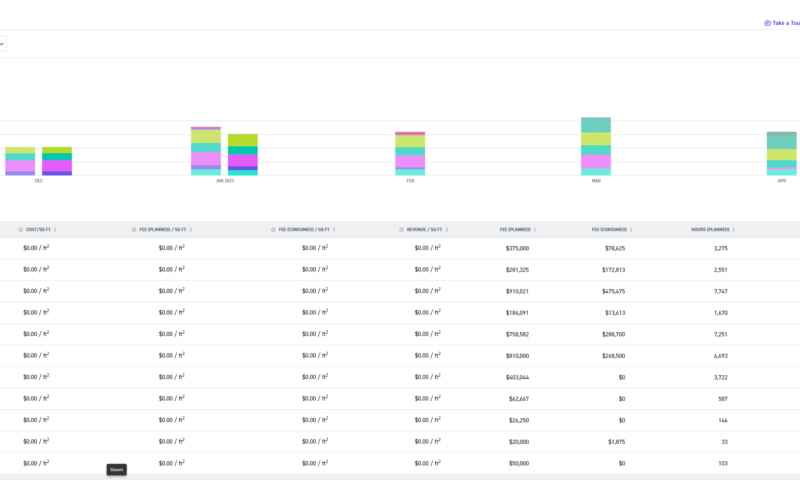
Regarding pricing, Monograph is one of the more costly task management tools. There’s no free plan, and the cheapest plan, Track, costs $30 per user per month. Track supports 20 projects, time management and invoicing. The $50 per user per month Grow tier adds unlimited projects, account support, forecasted workloads and insights on profit and loss.
Overall, Monograph is a loaded task management tool that’s ideal for construction projects. It handles resource planning effortlessly, has robust time-tracking capabilities and offers exceptional financial management tools.
We wish there were more team collaboration features; however, you can still do a lot with this software. Learn more in our full Monograph review.
| Yearly/Monthly | Track | Grow |
|---|---|---|
| Monthly | $30 ($360 per year) | $55 ($660 per year) |
| Yearly | $300 ($25 per month) | $540 ($45per month) |
2. monday.com
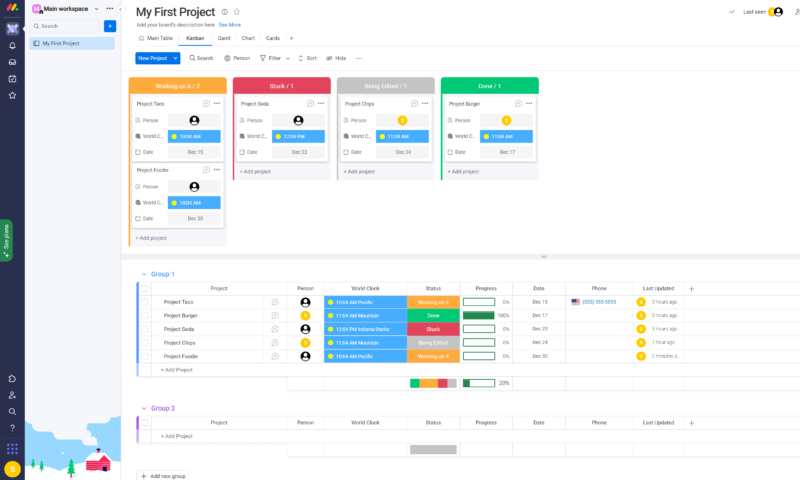
More details about monday.com:
- Pricing: Free, $9 per month (one-year plan) per user
- Provider website: monday.com
Pros:
- Very nice interface
- Versatile integrations
- Lots of tools & features
Cons:
- The free plan lacks features
- Basic tier isn’t competitive
monday.com is versatile enough — when you get into the paid plans — to make it a prime choice for architectural project managers who need to keep track of tasks, team members and workloads. While monday.com’s free tier and affordable Basic tier don’t offer much, the Standard and Pro plans make monday.com shine. You can find out why in our monday.com review.
Thanks to kanban boards, charts, timelines, calendars and a multi-project dashboard in the paid tiers, project managers can create, view project progress and control jobs efficiently. An app for mobile devices and desktops (available in the free plan), automations, communication tools and integrations make monday.com a fine choice for many, including architectural firms.
What makes monday.com one of our favorite task management suites is the user interface. monday.com is bright, colorful and easy to navigate. Everything about the software is intuitive, which means you can hit the floor running and be managing projects in no time. monday.com also offers a robust security suite, too.
The Power of Integrations and Automations
monday.com is great for managing complex projects on its own. However, you’ll get more out of it when you incorporate integrations and automations. The Standard plan allows 250 integration and automations actions per month. The Pro plan allows 25,000. With integrations, you can make all of your software work together seamlessly, which will help you meet project demands.
In the monday.com app store, you’ll find integrations to help with collaboration and communication, document management, cost tracking, file sharing, reports, invoicing and accounting, and more. You can also use automations to perform trivial tasks for you.
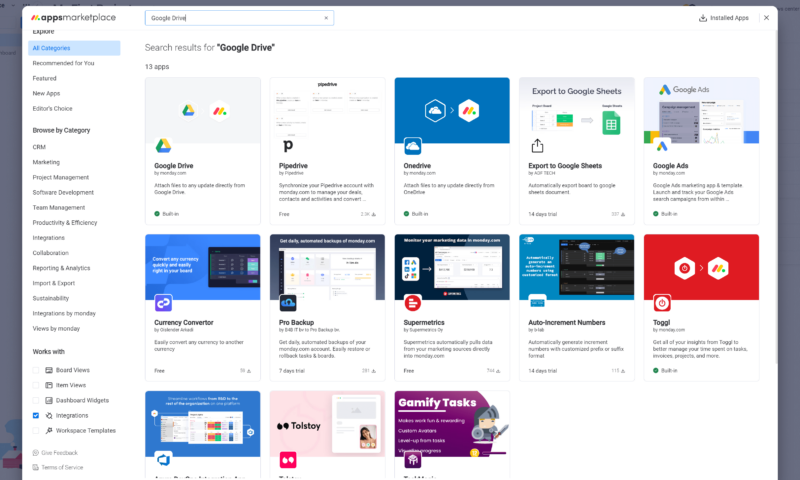
monday.com’s plan progression is a little strange. Avoid the free plan and just say no to the Basic tier, which offers unlimited seats and items, and not much else. If you’re serious about monday.com, jump into the $12 per user per month annual Standard plan. This tier offers everything from the Basic plan, plus integrations, automations, multiple views and 20GB of storage.
If you’re a large architectural firm, the right fit could be the $19 per user per month annual Pro plan, which adds 25,000 integrations and automations, time-tracking, formula and dependency columns, more views and 100GB of storage. There’s also a scalable Enterprise plan. Overall, monday.com is a capable piece of management software that should not be ignored.
- Maximum users: 2
- Minimum users: 3; All prices per user
- Minimum users: 3; All prices per user
More plans
- Minimum users: 3; All prices per user
- Enterprise-level features.
3. Wrike
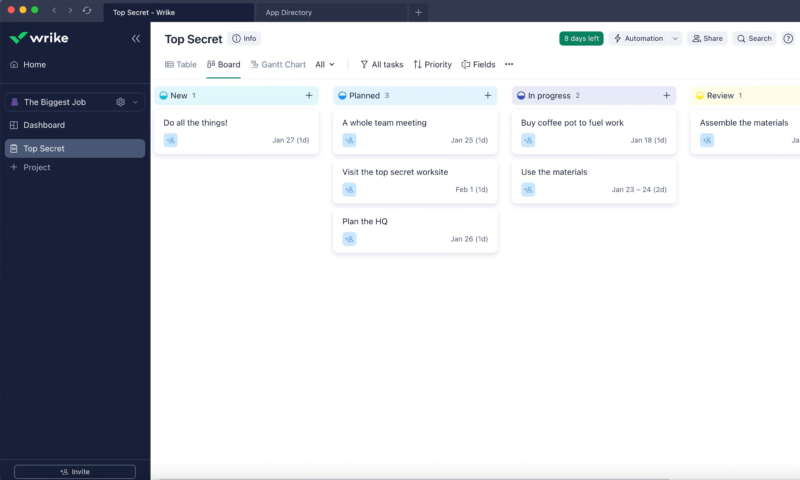
More details about Wrike:
- Pricing: Free, $10 per month (one-month plan) per user
- Provider website: wrike.com
Pros:
- A feature-rich free plan
- Lots of tools & features
- Good security features
Cons:
- Drab user interface
- Unintuitive software
- Big price jumps on plans
On the surface, Wrike looks a little tired. However, under the hood, this handy project management software is a cut above others thanks to its tools, exceptional views, integrations with popular apps, automations and robust security. We won’t go deep into each of Wrike’s tiers here, but if you’d like to know more about the paid plans, check out our full Wrike review.
Like monday.com, Wrike was not designed as dedicated management software for architects; however, this is not to say Wrike isn’t capable because it is, and then some. The free version of Wrike, which comes with a kanban board, is suitable for those who fly solo. However, if you have a large team, you’ll want to step up to the Team or Business plans for your architectural projects.
In the paid tiers, you’ll get clean Gantt charts, dashboards and calendars. Managers will love unlimited projects and tasks. Two-factor authentication will put you at ease, and real-time reports, time-tracking, timesheets and more round out the feature set. Integrations and automations tie your Wrike account to many popular resource management and communication platforms, as well.
Multiple Views Make Wrike Versatile
What makes Wrike a powerful project management app is its versatility. Whether you like kanban boards, charts, timelines, calendar views or simple lists, Wrike has you covered. If you enjoy using different tools for simple or complicated projects, you’ll be pleased to know that switching between views and dashboards is painless.
Plenty of other elements, like well-thought-out desktop and mobile apps, make Wrike an excellent choice for architecture projects, but the clean, functional views are where Wrike really stands out.
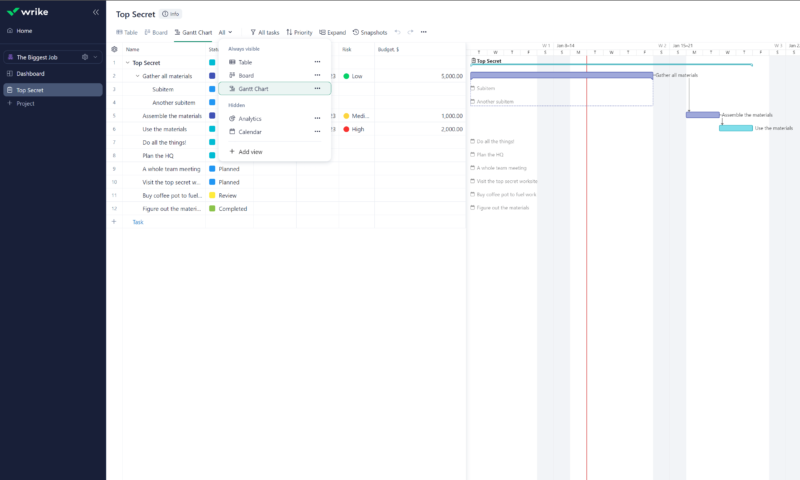
If you have a small firm with a handful of employees, you’ll find that the free tier has enough features to get you started. However, the paid plans are essential for those who need a more robust project management solution. The Team plan costs $10 per user per month and supports up to 25 members, while the $25 per user per month Business plan can accommodate up to 200.
If you need enterprise-grade security or advanced analytics, you might want to look into scalable Enterprise and Pinnacle plans. Overall, If you require a comprehensive collection of team management and task management features for your architecture firm, it’s hard to go wrong with Wrike.
- Unlimited users. Basic features.
- Price is per user. Plans for 5, 10 and 15 users.
- Price is per user. No monthly option. Plans for 5 to 200 users.
More plans
- For large teams; Enterprise-grade security and scalability; Plans for 5 to an unlimited number of users.
- For teams with complex work needs; Advanced tools and analytics for complex work; 5 to unlimited users
4. TeamGantt
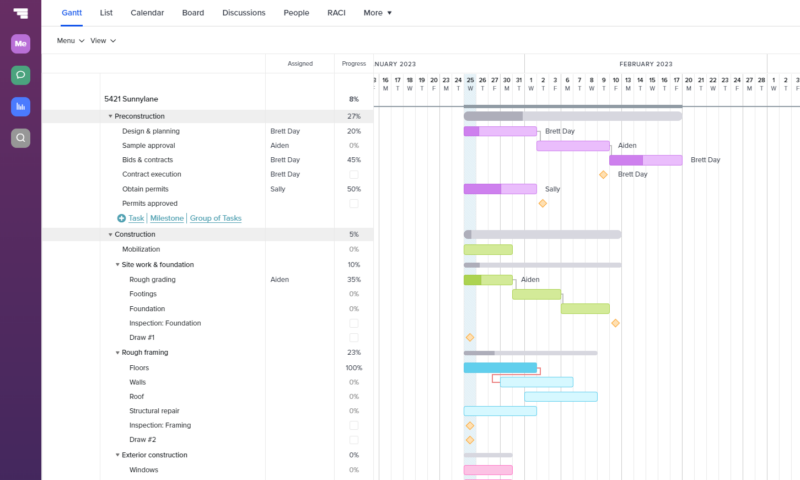
More details about TeamGantt:
- Pricing: Free,
- Provider website: teamgantt.com
Pros:
- A superb free Gantt tool
- Easy to pick up & use
- Nice tutorials & support
Cons:
- Limited feature set
- Paid tiers are costly
As far as Gantt charts go, we don’t think you’ll find an easier — or prettier — chart to use than the one on offer at TeamGantt. The free software does have limitations, and TeamGantt’s paid tiers are pricey. Still, when you start using TeamGantt, you’ll quickly realize just how good the management software is, and how useful it can be, for architecture firms.
Once a project is set up, you can drag-and-drop tasks and track progress easily, thanks to the large workspace. Assigning jobs is a breeze, and you can quickly create task dependencies. There are templates included that will help get you started, and you can link TeamGantt to other project management apps, like Trello, and communications tools, like Slack, via integrations.
However, other tools, like kanban boards, time-tracking, hourly estimating, workloads, reports, portfolio management, scheduling and discussions, are locked behind a paywall. If you want to use TeamGantt for challenging projects, you’ll need to pay up. You can find out more about the pricing structure and features of this software in our TeamGantt review.
Communication Tools
Sign up for a premium tier and you’ll get access to a user-friendly communications tool called discussions. In the discussions tab, you’ll find a slick collaboration tool that lets you chat with your team about the project you’re working on.
The Discussions tab looks like many message boards, in that you can see all of the chats you’re having with individual team members. The chats can also happen in real time, which is always a plus when time is of the essence. If you don’t need to have a full-blown discussion, you can also leave comments on individual tasks. Overall, TeamGantt makes communication simple.
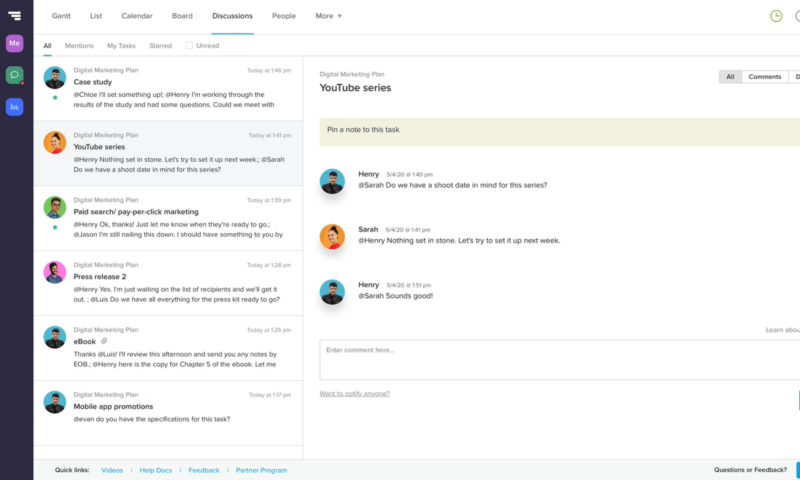
Regarding pricing, the free TeamGantt plan allows one manager, one project, two collaborators and 60 tasks. However, it only offers the Gantt chart and not much else. The per manager per month Lite plan allows five projects and five collaborators per manager, and gives access to different views and integrations.
The $49 per manager Pro tier offers unlimited collaborators and tasks, 20 projects and adds many of the tools discussed above. The $ Enterprise plan adds advanced admin features. If you like using Gantt charts, TeamGantt could be the project management software for you.
- 2 users (1 manager)
- Unlimited
- Unlimited
5. ClickUp
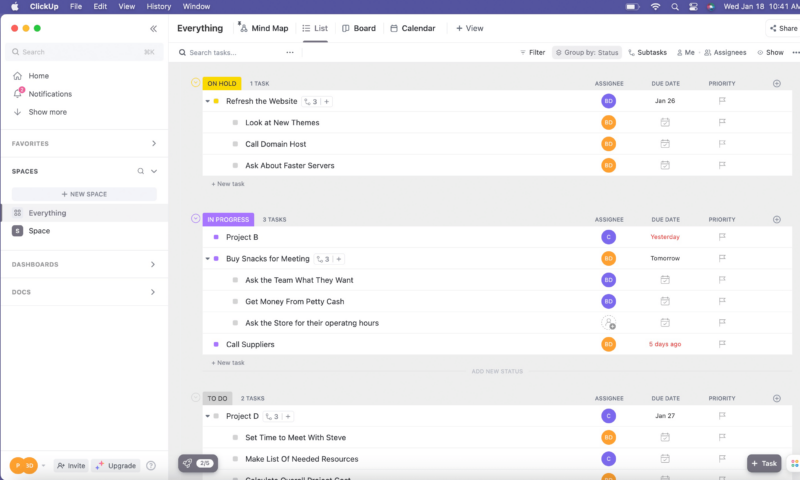
More details about ClickUp:
- Pricing: Free, $7 per month (one-year plan)
- Provider website: clickup.com
Pros:
- Very feature rich
- Strong free & paid plans
- Suits simple & complex tasks
Cons:
- Learning curve is a little steep
ClickUp, a versatile tool with a slick user interface and a unique take on plan progression, is the final entry on our list of project management software for architecture firms. ClickUp offers a free plan, which includes unlimited tasks and free plan members, real-time chat, sprint management and time tracking. However, it’s the paid plans that make ClickUp shine.
When you move into the various paid tiers, you’ll gain access to unlimited storage, teams, integrations, unlimited dashboards, Gantt charts, custom fields, goals and portfolios, resource management, workload management and advanced automations. The list of tools is too extensive to cover here, so feel free to read our full ClickUp review to learn more.
ClickUp also offers a good level of security, so you’ll have nothing to worry about in that regard. The only negative when it comes to ClickUp is that the software, while clean and easy on the eye, can be challenging to learn. Things like the mind map, an excellent brainstorming tool, are powerful when you know how to use them, but frustrating beforehand. Luckily, you can check out our ClickUp guide to learn everything you need to know.
Integrations for Everyone and Everything
Out of the box, you’ll find that ClickUp is fine project management software for most; however, to make it an ideal project management option for architects, you’ll need to lean on integrations. Fortunately, this is an area where ClickUp shines.
ClickUp integrates with over 1,000 tools, including Slack, Everhour, Google Drive, Microsoft Teams, Clockify, Salesforce and Time Doctor (a tool that enables you to invoice clients). We have a comprehensive guide on how to create a ClickUp-Slack integration.
You’ll also find integrations for document management and more. All of the integrations, along with the features that ClickUp provides, help make it suitable architectural project manager software.
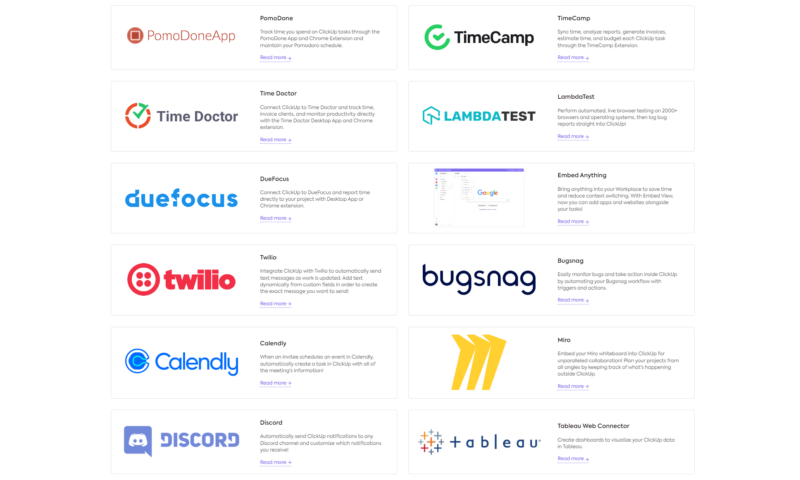
ClickUp’s plan progression is unique because most tools are available in the free tier. However, the tools have limitations on how many times they can be used each month, which differ by tier. Still, the plans are all affordable. The Unlimited annual plan costs $7 per user per month and provides unlimited storage, integrations, dashboards, Gantt charts, resource management, and goals and portfolios.
The $12 per user per month annual Business plan adds unlimited teams, advanced security, automations and time management, while the Enterprise tier adds advanced admin and security features, and more. You have to contact ClickUp for a tailor-made quote.
Overall, ClickUp is a solid choice for managers working in the architectural field. While you may have to rely on integrations more here than in other software, ClickUp is still more than capable of handling complex tasks with ease.
- Basic functionality with some limitations
- All prices per user
- All prices per user
Honorable Mention: Deltek Ajera
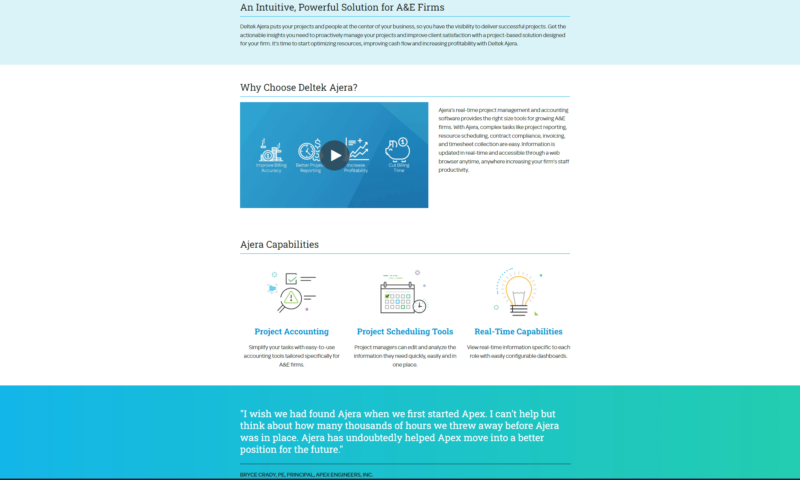
It would be remiss of us not to mention Deltek Ajera when discussing software that’s geared towards project management in the field of architecture. Many in this line of work consider Deltek Ajera to be the leading piece of project management software. It has been well-reviewed by many other outlets and deserves mention in our roundup.
Deltek Ajera features a robust suite of features such as comprehensive financial and project planning tools and real-time information on every member of your team. You can quickly create and send invoices and schedules, and Deltek Ajera can check contract compliance and create enough reports to keep project managers informed and on top of any project.
Unfortunately, it’s not easy to sign up for a Deltek Ajera plan, and despite our best efforts, we could not acquire the software for testing. However, we know that the platform provides powerful tools dedicated to making the life of an architect that much easier. You can request a demo of the software by heading to the official Deltek Ajera website.
Final Thoughts
Some project management solutions are specialized for certain professions. While some cater to interior designers, others are engineered to suit the complex world of architecture management. In this case, we think that Monograph excellently sets the the standard thanks to its task and resource management tools and financial management solutions.
We urge you to take all the software for a spin via their trials to see if you can utilize what they offer. You can’t go wrong with any of the software we’ve covered, but it never hurts to try them each out and see which you like best.
If you’re building a reliable software stack to keep your designs and project organized, there’s a software tool for your go-to operating systems. Be sure to check out our guides on the best project management software for Mac and project management software for Windows.
Have you used any of the project management software suites we’ve listed? Do you have any other suggestions? Let us know in the comments, and thank you for reading.
FAQ
The two pieces of software on our list that architects use the most are Monograph and Deltek Ajera. These software suites offer good task and resource management tools and strong financial and document management solutions.
Absolutely. Many architects today wear multiple hats, including project manager, finance manager and more.
The best overall project management software is still monday.com. While it may not have key features such as invoicing and scheduling baked in, the basic kanban boards, charts and other task management tools are still some of the best around, and it’s geared towards multiple use cases.


